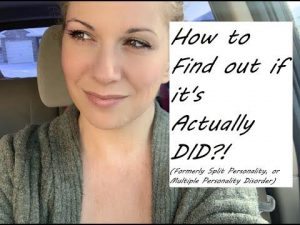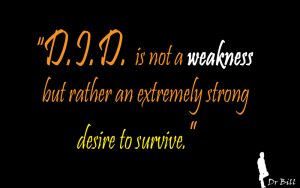When an individual comes seeking help for their problem, often the therapist will not know they are presenting symptoms of DID. Although the indicator of switching between alter personalities is a sure sign that DID may be present, this is very seldom witnessed in a counseling session unless the therapist already knows something about the individual that would indicate DID may be possible.  Therefore, it is important to be aware of some of the more common and significant indicators of DID. It is agreed upon by most working with dissociative individuals that these symptoms are grouped together in clusters. The following list may be possible signs to look for: depression, anxiety, panic, confusion, phobia, dysfunctional behavior (impulsivity, acting out, abusiveness, explosiveness, borderline instability, self-mutilation, suicidality, promiscuity, and compulsivity), substance abuse or chemical dependency, amnesia, ego-dystonic impulses, psychosomatic complaints, headaches, conversion disorder, disturbing imagery or memory recall, “flashbacks” of traumatic experiences, depersonalization, hallucinations (primarily auditory, but occasionally visual), and eating disorders.
Therefore, it is important to be aware of some of the more common and significant indicators of DID. It is agreed upon by most working with dissociative individuals that these symptoms are grouped together in clusters. The following list may be possible signs to look for: depression, anxiety, panic, confusion, phobia, dysfunctional behavior (impulsivity, acting out, abusiveness, explosiveness, borderline instability, self-mutilation, suicidality, promiscuity, and compulsivity), substance abuse or chemical dependency, amnesia, ego-dystonic impulses, psychosomatic complaints, headaches, conversion disorder, disturbing imagery or memory recall, “flashbacks” of traumatic experiences, depersonalization, hallucinations (primarily auditory, but occasionally visual), and eating disorders.
Other common dissociative symptoms can be:
- Nightmares – these could be brought on from traumatic memories of the past.
- Loss of time – the individual may not have any memory of where they were or what they did at certain times.
- Handwriting differences – this may be noticed by the person especially if they journal their life events.
- Differences in appearance – changes in the way they dress, wear their hair or any other apparent drastic changes in appearance.
- Little or no memories of childhood – although memories from one’s childhood will vary in details, the dissociative person’s memories may be entirely absent.
- Amnesia – although amnesia is no longer required for a definitive diagnosis of DID, this can be present among Alters that are committed to covering up the loss of time or certain memories.
- Trance-like behaviors – this can be described as staring off into deep space or being lost in deep thought.
- Switches – it is helpful to be able to witness the changing from one Alter to another, but sometimes this is imperceptible, even to the individual. Indicators that this may be going on can be facial expressions, habits, or even the blinking of the eyes with a sudden ‘snapping of the head’ as if someone punched them. Also, listen for the use of the pronoun “we”, although often Alter personalities will avoid using it so as not to give them away.
- Hearing voices inside the head – some dissociative (multiples) will report hear-ing voices in their head. These may sound like “arguments” among themselves.
- Others report “loud thoughts” as a way to describe this symptom. The voices may use “you” instead of “I”, and will very often be voices of condemnation against the host or dominant
 personality.
personality.
Still other symptoms will be of the effective nature. Most multiples will experience sporadic bouts of depression and periods of explosive anger. Their mood swings will be manifested with little to no warning or apparent reason, and can be very discomforting to those that are close to them. They will often have abnormal fears with constant anxiety manifesting, even though, there is nothing to fear at present. Some will become numb and almost emotion-less, or seem unable to express the appropriate emotion for what would be considered reasonable for a given situation. An example of this would be the inability to cry at a funeral, or to laugh at a funny joke or scene.
Some may report somatic symptoms that manifest as frequent and extreme headaches, a fluctuation of medical symptoms with no medical reason, and unexplained bruises, scratches or pain in the body that cannot be explained. It can be that certain alter personalities in the system are aware of these problems while others, including the host are not.
Behavior symptoms may include, in addition to what has already been mentioned, described as the inability to “pull one’s life together”. Multiples may have a track record of repeated failures in school, their jobs, and in relationships. Some will have achieved great successes in life while at the same time describing their life as “falling apart” inside. The stress in the system will often cause the multiple to breakdown and decrease their ability to function normally or at least to a level they once were able to. This decreased ability to function is a sure sign that the system is beginning to deteriorate. These symptoms often but not always begin to exhibit when the person is entering their 30’s or 40’s.
Mental symptoms will be characterized by confusion. The confusion could be about time whether something just happened or occurred a few hours, days or weeks ago. It could also be confusion about possessions. They may find that they had lost or acquired properties about which they have no knowledge of how or when they got them. This confusion can also be over their responsibility about certain things they said or did without any memory, and to avoid a possible conflict, they will just admit to it. Finally, they will have low self-esteem, which all victims of severe abuse, especially when sexual in nature, show on varying levels about their self-worth.
Of all the symptoms presented above, one seems to be prevalent by almost every person with DID. That is of hearing voices. These may sound like arguments or loud voices that are shouting in their head. Many are afraid to talk about this or to mention the phenomenon because of fear that they may get a diagnosis of schizophrenia. Based on the symptoms of hearing voices, there is a strong possibility that some patients were given a diagnosis of schizophrenia when, in fact, they most likely were DID. There is a significant difference between the voices that a DID person hears versus the sounds that a schizophrenic hears. Both are in fact hearing voices, but the main difference is how they are perceived. For the DID, the voices will only be internal while, for the schizophrenic, the voices will come as auditory hallucinations. They may appear they are coming from thin air or from across the room, perhaps from an imaginary person or object that they believe is speaking to them. That is classic schizophrenia and not DID. However, there is always the possibility that these two diagnoses could be comorbid. This phenomenon along with many of the others listed above can be defined as psychological. Nevertheless, it might be added that voices in the head is a phenomenon that is also associated with demonic possession, and therefore, this phenomenon may not only be defined as purely psychological in nature, but it may also be defined as a spiritual manifestation.
When a patient confides to a therapist that they hear voices, the first step in the examination is to find out if there are actual voices, what they are saying to the patient, how many are there, and what the tone and temperament of their speech is. The voices may be speaking to the patient ordering them to do something, or they may be just a conversation among them-selves. The DID patient might describe the voices as strictly internal, coming from an external area of a room, or from what they may believe to be a microphone or microchip implant in their heads. It is generally accepted that both schizophrenic and DID patients do often suffer from voices. However, if the voices are more like loud thought or a conversation going on in their heads, it is usually not considered classic schizophrenia. However, this does not rule out the possibility that the voices could also be demonically inspired. Obviously, further testing should be completed before assuming any of these diagnoses.
Most of the characteristics associated with dissociation can be hidden from others easily, and quite often, the person exhibiting these symptoms is unaware of them. The safe approach and advice for the therapist is until they have met an alter personality; it is not DID. The therapist may likely suspect DID, and later their assumptions may prove to be correct, but until all five criteria as outlined in the DSM-5 are met, it would be inappropriate to give a diagnosis of DID. Until that time, a diagnosis of dissociative disorder not otherwise specified (DDNOS) might be best.
If you believe you or a loved one may be suffering from any of the symptoms listed above, you’ve come to the right place. Contact me to schedule a free consultation to learn more.

 personality.
personality.
